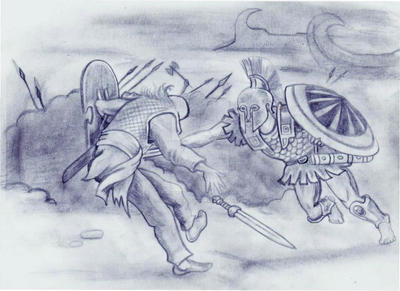Overview
Introduction to the Battle of Thermopylae
The Battle of Thermopylae was a significant event in ancient Greek history that took place in 480 BCE. It was a part of the larger Greco-Persian Wars, which lasted from 499 BCE to 449 BCE. The battle occurred at the narrow pass of Thermopylae, a strategic location that connected Thessaly with central Greece. This pass was chosen by King Leonidas I of Sparta and his allies as the defensive position to confront the invading Persian forces led by King Xerxes I. The Greek city-states, primarily Sparta and Athens, united to defend their homeland against the Persian invasion. The Battle of Thermopylae showcased the military prowess of the Greek warriors, their determination to protect their land, and the heroic sacrifice made by the Spartan warriors.
Historical Context
The Battle of Thermopylae, which took place in 480 BC, was a significant event in ancient Greek history. It occurred during the Greco-Persian Wars, a series of conflicts between the Persian Empire and the Greek city-states. The Persian Empire, led by King Xerxes I, sought to expand its territory and exert control over Greece. This invasion posed a major threat to the independence and autonomy of the Greek city-states, leading to a united effort to defend against the Persian forces. The Battle of Thermopylae was a pivotal moment in this conflict, showcasing the strength and determination of the Greek warriors.
Key Players and Forces
The Battle of Thermopylae involved several key players and forces from both the Greek and Persian sides. On the Greek side, the most prominent force was the Spartan army, known for their exceptional military prowess and discipline. Led by King Leonidas, the Spartans were joined by other Greek city-states, including Thespians and Thebans, forming a small but highly skilled and determined force. The Persian forces, led by King Xerxes, consisted of a vast army comprising soldiers from various nations within the Persian Empire. This included infantry, cavalry, and naval units, as well as elite troops known as the Immortals. The clash between these two forces would shape the outcome of the battle and have far-reaching political implications.
Military Strategy

The Greek Defensive Position
The Greek defensive position at the Battle of Thermopylae was strategically chosen to take advantage of the natural terrain and narrow passageway. The Greeks, led by King Leonidas of Sparta, positioned themselves at the entrance of the Thermopylae pass, which was flanked by steep cliffs and the sea. This defensive position allowed the Greeks to effectively block the Persian army’s advance, forcing them into a confined space where their superior numbers became a disadvantage. The Greeks also constructed a defensive wall, known as the Phocian Wall, to further fortify their position. This defensive strategy created a bottleneck, limiting the Persian forces’ ability to maneuver and maximizing the effectiveness of the Greek hoplites’ phalanx formation. The Greek defensive position was a key factor in their ability to hold off the Persian invasion for several days, despite being heavily outnumbered.
The Persian Invasion Plan
The Persian invasion plan was meticulously crafted and aimed to crush the Greek resistance at Thermopylae. King Xerxes I of Persia assembled a massive army of over 100,000 soldiers, including infantry, cavalry, and naval forces. The Persians strategically positioned their troops to surround the Greeks and cut off their retreat. They also utilized their superior numbers to launch wave after wave of attacks, overwhelming the Greek defenses. Additionally, the Persians employed various siege tactics, such as building a canal to bypass the Greek naval blockade and using battering rams to breach the Greek fortifications. This well-coordinated and relentless invasion plan showcased the Persian Empire’s military might and determination to conquer Greece.
Tactics and Maneuvers
The Battle of Thermopylae witnessed a series of strategic decisions and tactical maneuvers that played a crucial role in the outcome of the conflict. The Greek forces, led by the renowned Spartan general Leonidas, strategically positioned themselves in a narrow pass at Thermopylae, taking advantage of the natural geography to create a formidable defensive line. This defensive position allowed the Greeks to effectively counter the Persian invasion plan, which aimed to overwhelm them with sheer numbers. The Greeks employed various tactics, such as the use of phalanx formations and coordinated attacks, to fend off the Persian forces and inflict significant casualties. Despite the overwhelming odds, the Greeks displayed remarkable military prowess and adaptability, constantly adjusting their tactics to respond to the changing dynamics of the battle.
Heroic Sacrifice

The Spartan Warriors
The Spartan warriors were highly trained and disciplined soldiers who played a crucial role in the Battle of Thermopylae. Known for their exceptional physical strength and unwavering loyalty to their city-state, the Spartans were regarded as the finest warriors in ancient Greece. Trained from a young age in the art of warfare, they underwent rigorous military education and were subjected to grueling physical training. Their military prowess was unmatched, and they were well-prepared to face the Persian invasion. Led by King Leonidas, the Spartan warriors displayed immense courage and determination on the battlefield. Despite being vastly outnumbered, they fought with unparalleled bravery, forming a formidable defensive line that halted the advance of the Persian forces. Their unwavering commitment to their homeland and their willingness to make the ultimate sacrifice for their people earned them a place in history as legendary heroes.
Leonidas and the 300
The Battle of Thermopylae is most famously associated with Leonidas and his small force of 300 Spartan warriors. Leonidas, the king of Sparta, led this elite group of soldiers who were chosen for their exceptional bravery and military skill. They were known as the Spartan hoplites and were highly trained in the art of warfare. Despite being vastly outnumbered by the Persian forces, the Spartans, under the leadership of Leonidas, displayed remarkable courage and determination. They fought with unwavering loyalty to defend their homeland and uphold the honor of Sparta. The story of Leonidas and the 300 has become a symbol of heroic sacrifice and the indomitable spirit of the Greek city-states.
Other Acts of Bravery
In addition to the heroic actions of the Spartan warriors and the leadership of Leonidas and the 300, there were other acts of bravery that took place during the Battle of Thermopylae. One such act was by a group of soldiers from the city-state of Athens, who fought valiantly alongside the Spartans. These Athenian soldiers, despite being outnumbered and facing overwhelming odds, displayed remarkable courage and determination. They held their ground and fought fiercely, refusing to retreat or surrender. Their unwavering bravery inspired those around them and contributed to the overall resistance against the Persian invasion.
Political Implications

Impact on Greek City-States
The Battle of Thermopylae had a profound impact on the Greek city-states. It served as a rallying point for Greek unity and resistance against the Persian Empire. The city-states realized the importance of collective defense and cooperation in the face of a common enemy. The bravery and sacrifice displayed by the Spartan warriors, led by King Leonidas and the 300, inspired other Greek city-states to stand up against the Persians. The battle highlighted the significance of military strategy, discipline, and training in warfare. It also showcased the valor and heroism of the Greek soldiers, who fought to the death to protect their homeland. The Battle of Thermopylae became a symbol of Greek resilience and defiance, motivating the city-states to continue their resistance against the Persian invasion. The battle’s impact extended beyond its immediate military significance, shaping the political landscape of ancient Greece and influencing future conflicts and alliances.
Persian Perception and Response
The Persian perception of the Battle of Thermopylae was one of surprise and frustration. The Persian army, led by King Xerxes, expected an easy victory over the Greek forces. However, they were met with fierce resistance and strategic defense by the Greeks, particularly the Spartan warriors. This unexpected resistance caused confusion and delay in the Persian advance, allowing the Greeks to hold their ground for an extended period of time. The Persian response to this unexpected challenge was to increase their efforts, bringing in more troops and employing different tactics to try and break through the Greek defenses. Despite their initial surprise, the Persians eventually managed to outflank the Greeks and achieve victory, but not without significant losses. The Battle of Thermopylae served as a wake-up call for the Persian empire, highlighting the resilience and determination of the Greek city-states. It also showcased the military prowess and bravery of the Spartan warriors, creating a lasting legacy and symbol of resistance against overwhelming odds.
Legacy and Symbolism
The Battle of Thermopylae left a lasting legacy and became a symbol of bravery, sacrifice, and resistance against overwhelming odds. The heroic stand of the Greek forces, particularly the Spartan warriors led by King Leonidas and the 300, has inspired countless stories, poems, and works of art throughout history. The battle’s political implications were far-reaching, as it showcased the determination and unity of the Greek city-states in the face of the Persian invasion. The Persian perception of the battle and their response to the defeat further solidified the significance of Thermopylae. The victory at Thermopylae also had a profound impact on the morale and confidence of the Greek forces, bolstering their resolve to continue the fight against the Persian Empire. The battle’s symbolism continues to resonate today, serving as a reminder of the power of courage, sacrifice, and the indomitable human spirit.
Avid Writer with invaluable knowledge of Humanity!
Upcoming historian with over 30 million views online.
“You make your own life.”





